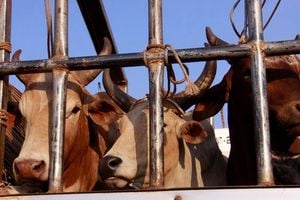
Butcheries chop goat meat at Kiamaiko Market in Nairobi.
The value of meat processed in Kenya grew to an all-time high of Sh304.6 billion in 2023, new data shows, underlining sustained demand for the dish despite high prices.
Fresh data by the Kenya National Bureau of Statistics (KNBS) data shows that Kenya produced 556,653 tonnes of meat worth Sh304.6 billion in 2023, marking a 19.8 per cent increase from 464,512 tonnes produced in 2022.
This was the first time that the value of meat produced in Kenya in a single year crossed the Sh300 billion mark, amid a 29 per cent increase in prices over five years.
“The total meat production in 2023 was 556,653 tonnes valued at Sh304.6 billion compared to 464,512 tonnes of meat valued at Sh240.7 billion in 2022,” notes the Kenya National Bureau of Statistics (KNBS) in the National Agriculture Production Report 2024.
The bulk 65 per cent of the meat produced in 2023 was consumed in the domestic market.
“The red meat (beef, mutton, chevon, and camel) increased by 23.3 per cent as compared to 2022 while white meat (pork, poultry, and rabbit) increased by 10 percent over the same period,” KNBS noted.
The value of meat produced in the country is a factor of growth in the number of animals being slaughtered and an increase in prices.
A tonne of meat averagely cost Sh547,260 in 2023, for instance, which was an increase from the average price of Sh518,231 in 2022. The price of meat has increased in recent years, coming from a low of Sh423,023 per tonne in 2019.
The number of livestock slaughtered has also grown from 66.2 million in 2020 to 80 million by 2023, with chicken forming the majority of the slaughtered animals.
The KNBS report notes that meat production has continued to grow in the country even as prices go up and amid a clear growth in animal population.
Cattle population, for instance, increased by 4.8 per cent from 20.9 million in 2022 to 21.9 million in 2023, KNBS attributing the growth to favourable weather conditions that brought plenty of pastures and drinking water for livestock.
The population of chickens went up from 61.7 million to 67 million.
“The indigenous chicken increased by 11.3 per cent from 48.8 million in 2022 to 54.3 million in 2023.
"The increase in indigenous chicken was attributed to the widespread promotion of poultry commercialisation by county governments and, preference of indigenous-based diets by consumers due to its perceived higher nutritional value and health compared to the exotic chicken. This triggered increased demand for both chicken meat and eggs,” the report notes.









